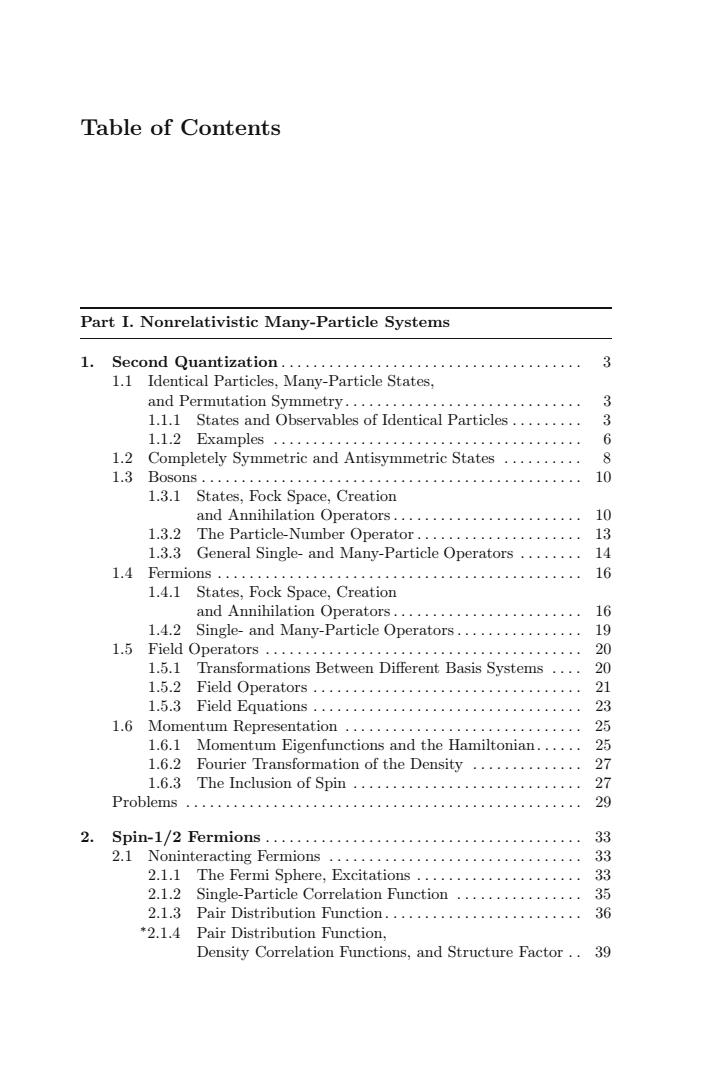正在加载图片...

Table of Contents Part I.Nonrelativistic Many-Particle Systems 1.Second Quantization. 3 1.1 Identical Particles.Many-Particle States. and Permutation Symmetry... 1.1.1 States and Observables of Identical Particles......... 1.1.2 Examples 6 1.Completely Symmetric and States 1.3Bo 10 1.3.1 States,Fock Space .Creation lation Operators 10 1.3.2 The Particle-Number Operator. 1.3.3 General Single-and Manv-Particle Operators .......14 1.4 Fermions... 16 1.4.1 States,Fock Space,Creation and Annihilation Operators … 16 1.4.2 Single-and Many-Particle Operators......... 10 1.5 Field Op rmations Between Different Basis Systems.... 20 Field 1.5.3 Field Equations ................................. 23 1.6 Momentum Representation.............................. 25 1.6.1 Momentum Eigenfunctions and the Hamiltonian...... 25 1.6.2 Fourier Transformation of the Density 27 1.6.3 The Inclusion of Spin 27 Problems 29 2.Spin-1/2 Fermions 33 2.1.1 The Fermi Sphere,Excitations 2.1 Noninteracting Fermions 33 23 2.1.2Si ngle-Particle Co lation Function 35 Distribution Function......................... 36 Pair Distribution Function, Density Correlation Functions,and Structure Factor..39 Table of Contents Part I. Nonrelativistic Many-Particle Systems 1. Second Quantization ...................................... 3 1.1 Identical Particles, Many-Particle States, and Permutation Symmetry. . . . . . . . . . . . . . . . . . . . . . . . . . . . . . 3 1.1.1 States and Observables of Identical Particles . . . . . . . . . 3 1.1.2 Examples . . . . . . . . . . . . . . . . . . . . . . . . . . . . . . . . . . . . . . . 6 1.2 Completely Symmetric and Antisymmetric States . . . . . . . . . . 8 1.3 Bosons . . . . . . . . . . . . . . . . . . . . . . . . . . . . . . . . . . . . . . . . . . . . . . . . 10 1.3.1 States, Fock Space, Creation and Annihilation Operators . . . . . . . . . . . . . . . . . . . . . . . . 10 1.3.2 The Particle-Number Operator . . . . . . . . . . . . . . . . . . . . . 13 1.3.3 General Single- and Many-Particle Operators . . . . . . . . 14 1.4 Fermions . . . . . . . . . . . . . . . . . . . . . . . . . . . . . . . . . . . . . . . . . . . . . . 16 1.4.1 States, Fock Space, Creation and Annihilation Operators . . . . . . . . . . . . . . . . . . . . . . . . 16 1.4.2 Single- and Many-Particle Operators . . . . . . . . . . . . . . . . 19 1.5 Field Operators . . . . . . . . . . . . . . . . . . . . . . . . . . . . . . . . . . . . . . . . 20 1.5.1 Transformations Between Different Basis Systems . . . . 20 1.5.2 Field Operators . . . . . . . . . . . . . . . . . . . . . . . . . . . . . . . . . . 21 1.5.3 Field Equations . . . . . . . . . . . . . . . . . . . . . . . . . . . . . . . . . . 23 1.6 Momentum Representation . . . . . . . . . . . . . . . . . . . . . . . . . . . . . . 25 1.6.1 Momentum Eigenfunctions and the Hamiltonian. . . . . . 25 1.6.2 Fourier Transformation of the Density . . . . . . . . . . . . . . 27 1.6.3 The Inclusion of Spin . . . . . . . . . . . . . . . . . . . . . . . . . . . . . 27 Problems . . . . . . . . . . . . . . . . . . . . . . . . . . . . . . . . . . . . . . . . . . . . . . . . . . 29 2. Spin-1/2 Fermions ........................................ 33 2.1 Noninteracting Fermions . . . . . . . . . . . . . . . . . . . . . . . . . . . . . . . . 33 2.1.1 The Fermi Sphere, Excitations . . . . . . . . . . . . . . . . . . . . . 33 2.1.2 Single-Particle Correlation Function . . . . . . . . . . . . . . . . 35 2.1.3 Pair Distribution Function . . . . . . . . . . . . . . . . . . . . . . . . . 36 ∗2.1.4 Pair Distribution Function, Density Correlation Functions, and Structure Factor . . 39